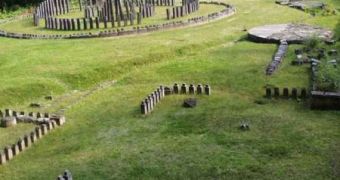The Orastiei Mountains (in the Carpathians) can be compared to a stone fortress surrounding with its walls the Hateg Depression in the county of Hunedoara (southern Transylvania, Romania). This region represented the center of the Dacian civilization, which reached its peak during the second stage of the Iron Epoch (300 BC to 106 AD). In this area, the Dacians developed a system of fortified fortresses and civil settlements, of which Sarmizegetusa Regia stood out, being the residence of the Dacian kings, from Burebista to Decebalus.
During the last Dacian war in 105-106 AD, the legions of the emperor Trajan conquered these fortresses and the Dacian capital in the Orastiei Mountains, destroying them almost completely.
In order to consolidate the Roman power in Dacia, Trajan ordered the building of a new capital in the Hateg Depression, over the place of former Sarmizegetusa. The new capital was named "Colonia Ulpia Traiana Augusta Dacica Sarmizegetusa" and for of 106-271 AD period (when Romans abandoned Dacia) it functioned as the politic, religious and cultural metropolis of the Roman province of Dacia.
The wall surrounding the city experienced a great development and at its peak it had 15,000-20,000 inhabitants, being the most populous city of the province. The metropolis stretched over 32.4 hectares and comprised the Palace of the Augustals, the Roman forum (square), amphiteather, temples (dedicated to the gods Liber Pater, Nemesis, Aesculapus, Hygeia, Silvanus, Mithras, Jupiter Dolichenus and others), houses, workshops, aqueducts and so on.
The Palace of the Augustals was located in the center of the city, being the location of a high college for priests, which had an important social role. The building had a quadrangle shape, with numerous rooms and a large central court. The forum was the center of the political life, the place of the most important meetings.
The amphitheater was the largest construction: it had an elliptical shape (90x70 m or 300x233 ft), having 4,000-5,000 seats, two main gates, which served for the entrance and exit of the gladiators, and two service gates. The benches were made of marble and stone in the first rows, and from wood in the case of the upper seats. The access to the seats was made via 12 large gates. After the abandoning of the Dacia by the Roman troops, the natives employed the amphitheater as fortress against the attacks of the migratory people. This is also the best preserved building of the ancient city. The high temple, built in the Corinthian style, was the largest cult edifice from the Roman Dacia: 46.3 m (154 ft) long and 34 m (113 ft) wide.
Through the placement of the edifices, elegance, refinement of the marble works (gushers, temples and so on), Sarmizegetusa was amongst the most beautiful cities of the Roman empire.

 14 DAY TRIAL //
14 DAY TRIAL //